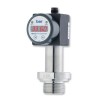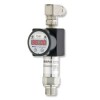Flush diaphragm electronic pressure switches are ideal for measuring liquid levels and triggering alarms or process control systems in hygienic or sanitary applications. These switches offer a reliable and accurate solution for maintaining optimal fluid levels and ensuring process safety.
 DS200P Sanitary Low Range Pressure Gauge, Switch and Sensor - All in one electronic switch, gauge and sensor designed specifically for use in the food, drink and biomedical industry for measuring process pressures.
DS200P Sanitary Low Range Pressure Gauge, Switch and Sensor - All in one electronic switch, gauge and sensor designed specifically for use in the food, drink and biomedical industry for measuring process pressures. DS201P High Range Flush Pressure Gauge, Switch and Sensor - High pressure sensor, electronic switch and digital gauge with an all welded stainless steel flush diaphragm for high viscosity liquids.
DS201P High Range Flush Pressure Gauge, Switch and Sensor - High pressure sensor, electronic switch and digital gauge with an all welded stainless steel flush diaphragm for high viscosity liquids.
Find out more about Flush Diaphragm Electronic Pressure Switches to determine which product options and capabilities will best meet your application requirements.
Flush diaphragm electronic pressure switches are specifically designed for applications where the process media needs to be in direct contact with the sensing element. This type of pressure switch is characterized by its open diaphragm design, which allows the process media to directly interface with the diaphragm without any intervening components. This design is particularly beneficial for applications where hygiene and cleanliness are paramount, such as in the food and beverage, pharmaceutical, and biotechnology industries.
Working Principle
These switches utilize a piezoresistive sensing element that measures the pressure exerted by the process media on the diaphragm. As the pressure changes, the resistance of the piezoresistive element changes proportionally. This change in resistance is then converted into an electrical signal, which is typically a transistor switch output. The switch output can be used to control various devices, such as pumps, valves, or alarms.
Applications
The versatility of flush diaphragm electronic pressure switches makes them suitable for a wide range of applications. Their ability to accurately measure pressure in hygienic environments makes them particularly well-suited for industries such as food and beverage, pharmaceutical, and biotechnology.
- Liquid Level Control: Flush diaphragm pressure switches are commonly used to monitor and control liquid levels in tanks, vessels, and pipelines. For instance, they can be used to activate a pump when the liquid level falls below a certain threshold or to shut off a valve when the tank is full.
- Process Monitoring: These switches can also be used to monitor process pressures and trigger alarms or control actions when the pressure deviates from the set point. This is particularly useful in applications where pressure fluctuations can affect product quality or process safety.
- Hygienic Applications: The open diaphragm design makes these switches suitable for hygienic applications where cleanliness is critical. The absence of dead spaces or crevices prevents the buildup of bacteria or other contaminants, ensuring product purity and process integrity.
Advantages
Flush diaphragm electronic pressure switches offer several advantages over traditional mechanical pressure switches. Their solid-state design eliminates the need for moving parts, resulting in increased reliability and longer lifespan. Additionally, the flush diaphragm configuration provides a hygienic solution for pressure measurement in applications where cleanliness is critical.
- Solid-State: Their solid-state design eliminates the need for moving parts, resulting in increased reliability and longer lifespan.
- High Accuracy: Piezoresistive sensing elements provide high accuracy and repeatability in pressure measurement.
- Hygienic Design: The flush diaphragm design eliminates dead spaces and crevices, making it ideal for hygienic applications.
- Compact Size: These switches are typically compact and lightweight, making them easy to install in tight spaces.
- Wide Range of Applications: Flush diaphragm pressure switches can be used in a variety of applications, including liquid level control, process monitoring, and leak detection.
Industries
The unique characteristics of flush diaphragm electronic pressure switches make them ideal for use in a variety of industries. The hygienic design and accurate pressure measurement capabilities of these switches are particularly valuable in industries where maintaining product purity and process integrity is essential.
- Food and Beverage: Monitoring liquid levels in tanks and vessels, ensuring product quality and safety.
- Pharmaceutical: Controlling process pressures in reactors and other equipment, maintaining sterile conditions.
- Biotechnology: Monitoring and controlling fluid levels in bioreactors and fermenters, optimizing cell growth and product yield.
- Water Treatment: Measuring water levels in tanks and reservoirs, ensuring efficient water management.
Use Cases
- Monitoring the level of milk in a storage tank at a dairy processing plant.
- Controlling the pressure of a sterile solution in a pharmaceutical filling line.
- Measuring the level of liquid in a bioreactor used for cell culture.
- Detecting leaks in a water pipeline.
